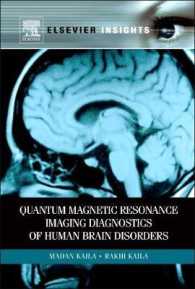基本説明
Previous ed.: 2008.
Full Description
Everything you need for success on the EMT-Paramedic exam in one complete streamlined review!If you want to score high on the EMT-Paramedic exam, you need McGraw-Hill's EMT-Paramedic. This essential review helps you think through pre-hospital medicine while covering the most critical information. Each chapter begins with a clinical scenario, followed by a bulleted overview of key topics and then summarized by Q&A at the end of every chapter. An introductory chapter offers valuable exam preparation tips, the do's and don'ts of answering multiple-choice questions, and more.You'll also find a complete practice exam to test your knowledge. The online question bank allows you to choose your questions by topic and hone in on your strengths and weaknesses. No other book boosts your chances for success like McGraw-Hill's EMT-Paramedic.Turn to this all-in-one review for:High-yield outline format bolstered by Q&A, clinical scenarios, and easy-to-remember bulleted content Seven sections that correspond incorporate the new 2010 Paramedic National CurriculumNew section on Advanced Life Support Monitoring featuring chapters on 12 Lead ECG, Capnography, and Understanding Blood ChemistryA complete 180-question practice exam at the end of the book An online question bank with over 360 questions available at www.mcgrawhillemt.com
Contents
Exam Preparation TipsSection 1: PreparatoryChapter 1: EMS Systes/Roles and Responsibilities; Chapter 2: The Well-Being of the Paramedic; Chapter 3: Illness and Injury Prevention; Chapter 4: Medical/Legal Issues; Chapter 5: Ethics; Chapter 6: General Principles of Pathophysiology; Chapter 7: Pharmacology; Chapter 8: Venous Access and Medication Administration; Chapter 9: therapeutic Communications; Chapter 10: Life-Span DevelopementSection 2: AirwayChapter 11: Airway Management and VentilationSection 3: Patient AssessmentChapter 12: Patient AssessmentSection 4: TraumaChapter 13: Trauma Systems and Mechanism of Injury; Chapter 14: Hemorrhage and Shock; Chapter 15: Soft Tissue Trauma; Chapter 16: Burns; Chapter 17: Head and Facial Trauma; Chapter 18: Spinal Trauma; Chapter 19: Thoracic Trauma; Chapter 20: Abdominal Trauma; Chapter 21: Musculoskeletal TraumaSection 5: Medical EmergenciesChapter 22: Pulmonary Emergencies; Chapter 23: Cardiology; Chapter 24: Neurology; Chapter 25: Endocrinology; Chapter 26: Allergies and Anaphylaxis; Chapter 27: Gastroenterology; Chapter 28: Toxicology; Chapter 29: Hematology; Chapter 30: Infectious and Communicable Diseases; Chapter 31: Behavioral and Psychiatric Disorders; Chapter 32: Gynecology; Chapter 33: ObstetricSection 6: Special ConsiderationsChapter 34: Neonatology; Chapter 35: Pediatrics; Chapter 36: Geriatrics; Chapter 37: Patients with Special Challenges; Chapter 38: Acute Interventions for the Home Health-Care PatientSection 7: OperationsChapter 39: Ambulance Operations; Chapter 40: Medical Incident Command; Chapter 41: Rescue Awareness and Operations; Chapter 42: Paramedic Response to Hazardous Materials Incidents; Chapter 43: Crime Scene AwarenessSection 8: Advanced Life Support MonitoringChapter 44: 12-Lead ECG; Chapter 45: Capnography-The New Prehospital Vital Sign; Chapter 46: Understanding Blood and Blood ChemistryAnswers to Cahpter QuestionsPractice ExamPractice Exam AnswersIndexOnline Practice Exam at www.mcgraw-hillemt.comNER(01): WOW








